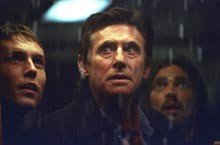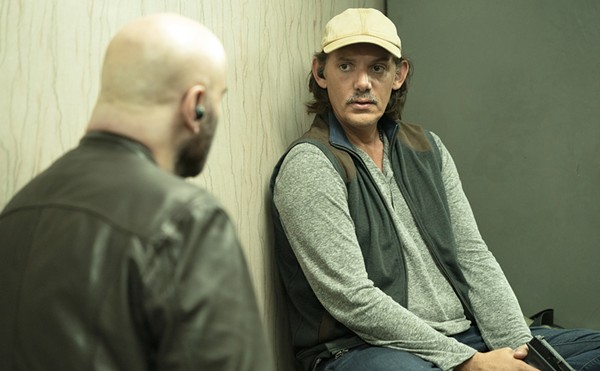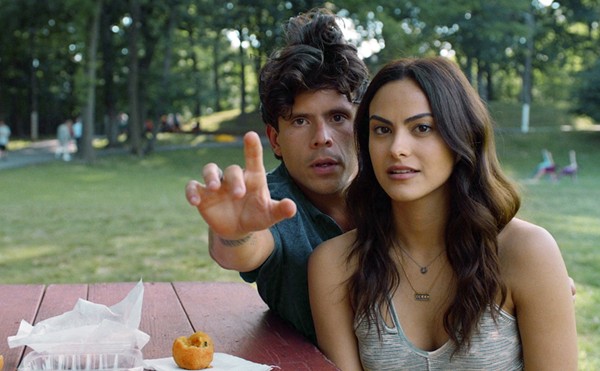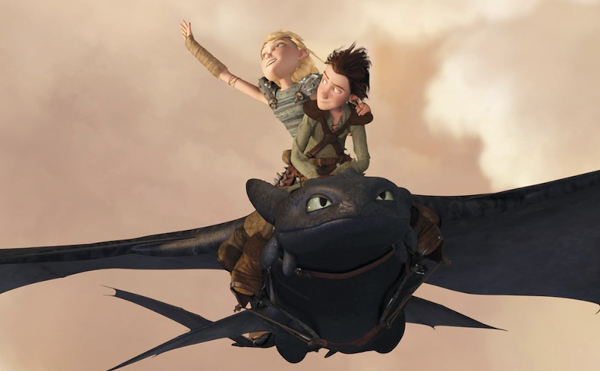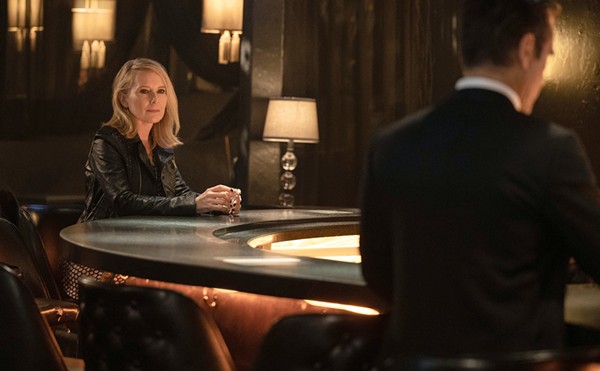"Hooked on Hogan's goatish hero"
Dir. Paul Schrader; writ. Robert Graysmith (book), Michael Gerbosi; feat. Greg Kinnear, Willem Dafoe, Maria Bello, Rita Wilson, Ron Leibman (R)
The running joke in Lord Byron's mock epic "Don Juan" is that the legendary debaucher is really a schmo, a feckless fellow at whom gorgeous women choose to fling themselves. In Auto Focus, Paul Schrader — whose provocations (as screenwriter or director) include Taxi Driver, The Last Temptation of Christ, and The Comfort of Strangers — offers a portrait of Bob Crane as an ordinary guy afflicted with sexual athlete's foot. The star of "Hogan's Heroes," a POW sitcom that ran on CBS from 1965 to 1971, Crane is as chipper after and about his 1978 murder, by an unknown assailant, as he is before. "That's how it is" is how he concludes the voiceover narration that frames the film and his disappointing life. "Men gotta have fun."
Two men in Auto Focus get a lot of women, but they lack much fun in their compulsions. The story of a man who is always scoring but never winning, the film is a study less of a life organized around seduction than of the seductiveness of seduction and of the seductions of celebrity. "Power is the great aphrodisiac," declared Henry Kissinger, but the illusion of power, Schrader demonstrates, is even greater. It is only when he is recognized everywhere as fictional Colonel Hogan that Crane discovers he is a phallic magnet.
At the outset of Auto Focus, Crane has been married 15 years to his high school sweetheart, Anne (Wilson), who regularly accompanies him and their three children to church. His beverage of choice is grapefruit juice. "I'm a likeable guy," he says, which is why the viewer stays with this grim spectacle of wholesomeness disintegrating. John Carpenter, a video technician played with Mephistophelean brilliance by Willem Dafoe, attaches himself to Crane, trolling with him for women and accepting the celebrity's castaways. Through all the graphic dissipation, expurgated slightly for American audiences, Crane remains an innocent. "I'm a normal red-blooded American man," he insists, and when that blood flows in a Scottsdale motel room, shed perhaps by Carpenter, we are shocked into recognizing that Don Juan was a schmo, who ended up in hell by furnishing it himself, with choice pieces of period kitsch. — Steven G. Kellman
Bowling for Columbine
"Angry, woeful, witty interrogation of American mania"
Writ. & dir. Michael Moore; feat. Moore, Charlton Heston, Marilyn Manson, Dick Clark, John Nichols, Matt Stone (R)
American exceptionalism, a belief that this country occupies a unique place in history, has been an article of faith from the Puritans to George W. Bush. But what exactly is unique about the United States? It is not democracy, prosperity, multiculturalism, amber waves of grain, or even shopping malls. As Michael Moore notes, what distinguishes us from every other developed nation is gun violence. More than 11,000 Americans are killed annually by firearms. Japan suffered 39 gun fatalities last year, the United Kingdom 68, Canada 165, France 255. Even Germany, the nation that produced the Holocaust, recorded only 381 deaths by bullet.
Bowling for Columbine is a cinematic essay through which Moore ponders the problem, in a zany style that is anything but ponderous. Early in the film, he opens an account in a Michigan bank that gives away rifles as a bonus to customers. "Do you think it's a little dangerous handing out guns in a bank?" Moore asks the manager. A chunky guy wearing duds that seem straight off the racks of Goodwill, Moore is a working-class Socrates who poses unsettling questions. "Why not use non-violent means?" he asks John Nichols, brother of Oklahoma City bomber Terry Nichols. "Gandhi was able to kick the British Empire out of India without firing a shot." Nichols, a soybean farmer who shares his brother's rancor and keeps a .44 magnum under his pillow, replies: "I'm sorry. I never heard about that."
On April 20, 1999, the world heard about a massacre in Littleton, Colorado. After bowling in the morning, two boys, armed with guns purchased legally, began a shooting spree at Columbine High School that left twelve students and one teacher dead. In Littleton, home of Lockheed Martin, the world's largest weapons manufacturer, Moore tries to fathom how the horror could have happened. Matt Stone, who co-created South Park and grew up in Littleton, describes his home town as "painfully normal." To understand the normalcy of pain in America, Moore travels between Michigan and Colorado and between anguish and prankishness in a quirky work no one else could or would have made.
In Bowling for Columbine, Moore returns to his home town, Flint, Michigan, the economically ravaged site of his first film, Roger and Me, when a six-year-old shoots a little girl dead at Buell Elementary School. He returns to Canada, site of his satirical feature, Canadian Bacon, to learn why firearm atrocities stop at the border. Though he does not quite unravel the mystery, he is able to barge in to irenic Canadians' unlocked houses.
Back in Michigan, Moore brings two Columbine victims to Kmart corporate headquarters to demand its stores cease selling the bullets that almost killed them. Ambushed on camera, Kmart officers prove more cooperative than General Motors CEO Roger Smith was in Roger and Me; they agree to end their nasty trade in ammunition. In Beverly Hills, Moore visits Charlton Heston, Moses of the NRA, who led defiant pro-gun rallies in Colorado and Michigan immediately following the school shootings. Why, asks Moore again, is the United States unique in its gory roster of homicides? "We have a history of violence," stammers Heston and walks away. Columbine concludes with that gutter ball. Moore himself fails to offer much more of an answer, but it is hard to walk away from his infuriating, grievous, and hilarious film, an exceptional response to American exceptionalism. — Steven G. Kellman
Ghost Ship
"Dead in the water"
Dir. Steve Beck; writ. Mark Hanlon; feat. Gabriel Byrne, Julianna Margulies, Ron Eldard, Desmond Harrington, Isaiah Washington, Emily Browning (R)
Pinning the label "rip-off" to Ghost Ship won't deter horror film fans around Halloween. The genre's devotees favor originality, but don't require it. The same goes for "cookie-cutter characters."
| Gabriel Byrne in Ghost Ship |
Maybe if I add "bland," or step away from the dictionary for "frightless," it would let even spook-fest aficionados know that they can skip this one. Really. Nothing to recommend it whatsoever.
That said, there are two moments that might have fit a good film. The opening credits, in pink, flourished letters over a blue sea, show for just long enough the passengers and crew of a luxury liner happily twirling on the dance floor, before they are sliced in half by a steel cable. Nice trick, followed by nothing that lives up to it.
At the end, a digitally enhanced flashback montage slams all the exposition we've been expecting into a couple of minutes. The sequence might even have rescued my interest, albeit briefly. Its one fault is unfortunately something more like a plague on modern movie-making: While I dig it in my headphones, heavy-duty rock 'n' roll does not belong everywhere, especially not behind action set in 1953. Despite increasingly massive audio production, heavy metal has become cliché and safe enough to plaster all over mainstream film. It ruined the very end of The Matrix, and has put small but painfully incongruous dents in Jet Li's kung fu movies. Word to the producers: Cut it out. There's much spookier and more dramatic music available. Look into it. — Jonathan Marcus
I Spy
"Any similarity is coincidental — so what?"
Dir. Betty Thomas; writ. Marianne Wibberley, Cormac Wibberley; feat. Eddie Murphy, Owen Wilson, Famke Janssen, Malcolm McDowell (PG-13)
First the bad news: In the recent spate of crass exploitation of familiar comic book/TV series/novel brands to sell movie tickets, I Spy may be the most dishonest and cynical. There's practically nothing tying this film to the droll humor of the television show on which it is based, except for the fact that this is a secret agent yarn featuring a black guy and a white guy. The chemistry here is nothing like that of the old Robert Culp/Bill Cosby team, and one wonders why the filmmakers would bother buying the rights to a title that very few in the target demographic will recognize anyway.
The good news is that, whatever you call it, I Spy is a pretty entertaining little summer flick, even if summer has already made its exit. It's neither laugh riot nor nail-biting actioner, but is strong enough on both fronts to keep the momentum going, whether the film is milking a well-placed satire of our good ol' boy President or careening through exotic Old World cobblestone streets. Wilson and Murphy both show, if not their very best sides, then far from their worst — and Wilson's halting manner turns an iffy Cyrano de Bergerac moment involving Janssen into a real show stopper. Nothing is taken very seriously here, even nuclear terrorism, and that's the way it should be, in this amusing little diversion from the onset of weightier fall fare. — John DeFore
Jackass: The Movie
"Causes uncontrollable giggling and gagging" Dir. Jeff Tremaine; writ. Tremaine, Spike Jonze, Johnny Knoxville; feat. Knoxville, Bam Margera, Chris Pontius, Steve-O, Dave England, Ryan Dunn (R)
All things verboten — playing with your food, eating yellow snow, sticking things up your rectum — were fodder for MTV's Jackass, a series cancelled after some dumb kid attempted one of its incredibly stupid amateur stunts. In three short seasons, the cast — professional skaters, an ex-circus clown, a midget, and pretty boy Johnny Knoxville — skyrocketed to cult status, although some of their finest moments never made it on the air. Jackass: The Movie brings these moments to the big screen, in 90 minutes of bad ideas and bare asses.
Despite prominent guest appearances by mega pro-skaters, director Spike Jonze, etc., The Movie doesn't pretend to be anything more than spliced footage of raunchy, bad behavior. There's neither plot nor script; it's simply a glorified episode of the show, uncensored and out of control. And it is funny — bellyachingly so — if you can find humor in poo, painful pranks, and the thong-clad "Party Boy" who prances around Japan with a bowtie and a boombox. I realize that the humor is in the most primitive, low-brow taste, but Jackass was enough to make me eager for the "Don't Try This at Home World Tour" on Sunday, November 3 at Sunset Station. — Wendi Kimura

